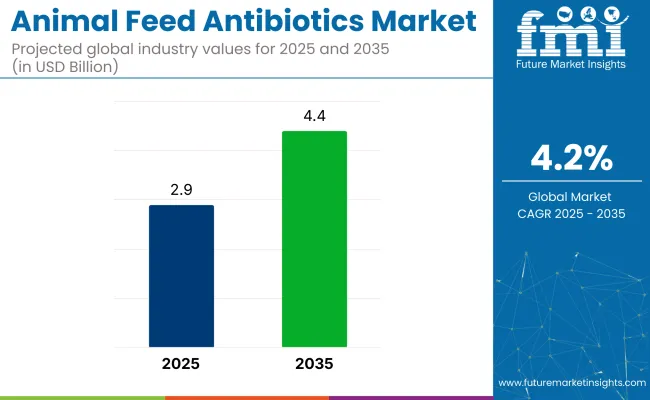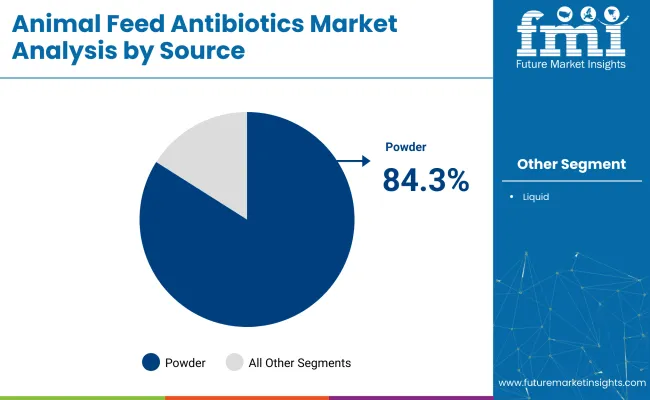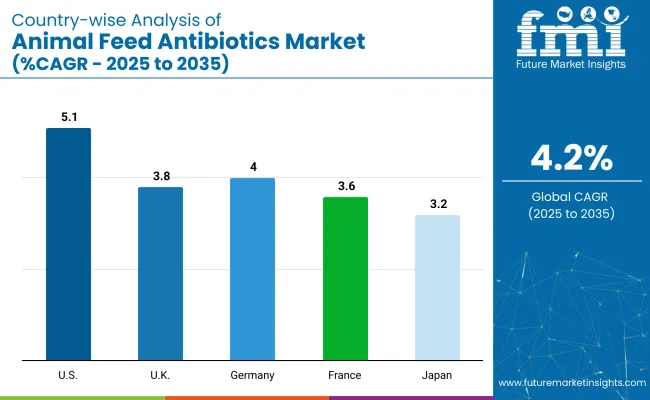The global animal feed antibiotics market is valued at USD 2.9 billion in 2025 and is slated to reach USD 4.4 billion by 2035, reflecting a CAGR of 4.2%.

| Metric | Value |
|---|---|
| Market Value (2025) | USD 2.9 billion |
| Forecast Value (2035) | USD 4.4 billion |
| Forecast CAGR | 4.2% |
Growth will be driven by increasing livestock farming, higher demand for animal protein, and advancements in antibiotic formulations that improve feed conversion rates. In addition, the rising focus on livestock health management and the prevention of infectious diseases will support market expansion, particularly in emerging economies where meat consumption is rising.
The USA is expected to grow the fastest in the market, with a CAGR of 5.1%, mainly due to its advanced livestock farming, high meat consumption, and strong investments in animal health solutions. Germany will follow with a 4.0% CAGR, driven by its strong livestock sector and focus on animal welfare and feed efficiency.
The UK is projected to grow at a CAGR of 3.8%, supported by steady demand for high-quality meat products.Food-producing animals will lead the animal type segment with and 80% market share, while powder will dominate the form segment with an 84.3% market share in 2025.
Strict government regulations have restricted the use of antibiotics as growth promoters in animal feed due to concerns over antimicrobial resistance impacting human health. Countries like China and members of the European Union have imposed bans and stringent policies limiting antibiotic use in livestock.
To comply with these regulations, companies are innovating by developing safer, species-specific antibiotics that are easily excreted without residue build-up. Recent advancements include biotechnology-driven natural antibiotic formulations and fermentation-based products that maintain feed efficiency while ensuring safety.
The animal feed antibiotics market holds a small but significant share within its parent markets. It accounts for approximately 5-7% of the overall animal feed market, given its specialized application in disease prevention and growth promotion. Within the animal nutrition market, its share is around 4-5%, as vitamins, minerals, and enzymes dominate
In the animal healthcare market, it represents about 3-4%, since vaccines and other therapeutics form larger segments. Within the feed additives market, animal feed antibiotics hold a substantial 10-12% share, highlighting their critical role in enhancing feed efficiency and livestock health despite tightening regulatory restrictions globally.
The animal feed antibiotics market segments include antibiotic type, form, animal type, sales channel, and region. The antibiotic type segment covers tetracyclines, penicillins, macrolides, sulphonamides, aminoglycosides, and others (lincosamides, fluoroquinolones, cephalosporins).
The form segment includes liquid and powder. The animal type segment incorporates food producing animals and companion animals. The sales channel segment consists of B2B and B2C. The regional segment includes North America, Latin America, Western Europe, Eastern Europe, Balkans & Baltic, Russia & Belarus, Central Asia, East Asia, South Asia & Pacific, and the Middle East & Africa.
Tetracyclines are the most lucrative segment, holding 35% market share, due to their broad-spectrum action, low cost, and wide use in livestock feed.
Powder form is the most lucrative segment, holding an estimated 84.3% market share. This dominance is driven by its ease of handling, long shelf life, and simple mixing with animal feed at farms and feed mills.

Food-producing animals are the most lucrative segment, accounting for over 80% market share. This dominance is driven by high antibiotic demand in poultry, swine, and cattle farming to prevent infections, promote faster growth, and improve feed efficiency.

B2B is the most lucrative sales channel, holding approximately 70% market share in 2025. This dominance is due to bulk purchases by feed manufacturers and large farms that buy directly from suppliers.
The global animal feed antibiotics market is growing steadily, driven by rising livestock farming, increasing demand for animal protein, and advancements in safe and effective antibiotic formulations.
Recent Trends in the Animal Feed Antibiotics Market
Challenges in the Animal Feed Antibiotics Market

Among the top countries, the USA shows the highest growth rate with a CAGR of 5.1% from 2025 to 2035, driven by advanced livestock farming and strong R&D investments. Germany follows with a 4.0% CAGR, supported by advanced nutrition practices and strict welfare standards.
The UK registers a 3.8% CAGR, reflecting balanced growth despite regulatory constraints. France records a 3.6% CAGR, driven by its large poultry sector, while Japan shows the lowest growth among these, with a 3.2% CAGR, due to stringent policies despite strong meat consumption.
This report covers an in-depth analysis of 40+ countries; the five top-performing OECD Countries are highlighted below.
The USA animal feed antibiotics market is poised to grow at a CAGR of 5.1% from 2025 to 2035. Growth will be driven by advanced livestock farming practices, rising meat consumption, and strict regulatory frameworks ensuring feed safety.
Animal feed antibiotics revenue in the UK is projected to grow at a CAGR of 3.8% from 2025 to 2035. Growth will be supported by efficient livestock production despite strict EU-aligned regulations.
The German animal feed antibiotics revenue is expected to grow at a CAGR of 4.0% from 2025 to 2035. Growth will be driven by advanced animal nutrition practices and a strong livestock sector.
Sales of animal feed antibiotics in France are anticipated to grow at a CAGR of 3.6% from 2025 to 2035. Market growth will be driven by a large poultry and swine farming industry.
The Japanese animal feed antibiotics market is expected to grow at a CAGR of 3.2% from 2025 to 2035. Growth will be supported by high meat consumption, especially poultry and pork.
The market is fragmented, with a mix of tier-one multinational companies and regional players competing based on pricing, innovation, distribution partnerships, and expansion strategies. Top companies focus on developing safer, residue-free, and species-specific antibiotic formulations to align with strict regulatory frameworks while maintaining market share.
Companies like Processing Company (MPC) and Green Farms Animal Feed Antibiotics compete by offering cost-effective formulations and expanding their distribution networks in emerging markets. Mauna Loa Nut Corporation, Hamakua Nut Company, and Suncoast Gold Animal Feed Antibiotics focus on niche product offerings and strengthening regional presence to cater to specific livestock segments.
Recent Animal Feed Antibiotics Industry News
| Report Attributes | Details |
|---|---|
| Current Total Market Size (2025) | USD 2.9 billion |
| Projected Market Size (2035) | USD 4.4 billion |
| CAGR (2025 to 2035) | 4.2% |
| Base Year for Estimation | 2024 |
| Historical Period | 2020 to 2024 |
| Projections Period | 2025 to 2035 |
| Market Analysis Parameters | Revenue in USD billions/Volume (Metric Tons) |
| By Antibiotic Type | Tetracyclines, Penicillins, Macrolides, Sulphonamides, Aminoglycosides, Others (Lincosamides, Fluoroquinolones, Cephalosporins, and Polypeptides) |
| By Form | Liquid, Powder |
| By Animal Type | Food Producing Animals, Companion Animals |
| By Sales Channel | B2B, B2C |
| Regions Covered | North America, Latin America, Western Europe, Eastern Europe, East Asia, South Asia & Pacific, Middle East & Africa |
| Countries Covered | United States, Canada, United Kingdom, Germany, France, China, Japan, South Korea, Brazil, Australia |
| Key Players | Processing Company (MPC), Green Farms Animal Feed Antibiotics, Mauna Loa Nut Corporation, Hamakua Nut Company, Suncoast Gold Animal Feed Antibiotics, Nut Company (PTY) Ltd., Wondaree Animal Feed Antibiotics, Midway Limited, Marquis Animal Feed Antibiotics, Nutworks Australia, and MacFarms |
| Additional Attributes | Dollar sales by value, market share analysis by region, and country-wise analysis. |
As per antibiotic type, the industry has been categorized into Tetracyclines, Penicillins, Macrolides, Sulphonamides, Aminoglycosides, and Others.
As per form, the industry has been categorized into Liquid and Powder.
This segment is further categorized into Food-Producing Animals (Poultry, Swine, Aquaculture, and Ruminants) and Companion Animals (Canines and Equines).
As per sales channel, the industry has been categorized into B2B and B2C (Veterinary Clinics and Shops, Pharmacy Stores, and Online Portal).
Industry analysis has been carried out in key countries of North America, Latin America, Europe, East Asia, South Asia, Oceania, and the Middle East & Africa.
The market is projected to reach USD 4.4 billion by 2035.
Tetracyclines lead the market, holding around 35% share in 2025.
The market is projected to grow at a CAGR of 4.2%.
USA is expected to grow at the fastest CAGR of 5.1% during 2025 to 2035.
The powder form is likely to hold 84.3% market share in 2025.






Our Research Products

The "Full Research Suite" delivers actionable market intel, deep dives on markets or technologies, so clients act faster, cut risk, and unlock growth.

The Leaderboard benchmarks and ranks top vendors, classifying them as Established Leaders, Leading Challengers, or Disruptors & Challengers.

Locates where complements amplify value and substitutes erode it, forecasting net impact by horizon

We deliver granular, decision-grade intel: market sizing, 5-year forecasts, pricing, adoption, usage, revenue, and operational KPIs—plus competitor tracking, regulation, and value chains—across 60 countries broadly.

Spot the shifts before they hit your P&L. We track inflection points, adoption curves, pricing moves, and ecosystem plays to show where demand is heading, why it is changing, and what to do next across high-growth markets and disruptive tech

Real-time reads of user behavior. We track shifting priorities, perceptions of today’s and next-gen services, and provider experience, then pace how fast tech moves from trial to adoption, blending buyer, consumer, and channel inputs with social signals (#WhySwitch, #UX).

Partner with our analyst team to build a custom report designed around your business priorities. From analysing market trends to assessing competitors or crafting bespoke datasets, we tailor insights to your needs.
Supplier Intelligence
Discovery & Profiling
Capacity & Footprint
Performance & Risk
Compliance & Governance
Commercial Readiness
Who Supplies Whom
Scorecards & Shortlists
Playbooks & Docs
Category Intelligence
Definition & Scope
Demand & Use Cases
Cost Drivers
Market Structure
Supply Chain Map
Trade & Policy
Operating Norms
Deliverables
Buyer Intelligence
Account Basics
Spend & Scope
Procurement Model
Vendor Requirements
Terms & Policies
Entry Strategy
Pain Points & Triggers
Outputs
Pricing Analysis
Benchmarks
Trends
Should-Cost
Indexation
Landed Cost
Commercial Terms
Deliverables
Brand Analysis
Positioning & Value Prop
Share & Presence
Customer Evidence
Go-to-Market
Digital & Reputation
Compliance & Trust
KPIs & Gaps
Outputs
Full Research Suite comprises of:
Market outlook & trends analysis
Interviews & case studies
Strategic recommendations
Vendor profiles & capabilities analysis
5-year forecasts
8 regions and 60+ country-level data splits
Market segment data splits
12 months of continuous data updates
DELIVERED AS:
PDF EXCEL ONLINE
Animal Antibiotics and Antimicrobials Market Size and Share Forecast Outlook 2025 to 2035
Animal Feed Additives Market Analysis - Size, Share, & Forecast Outlook 2025 to 2035
Animal Feed Organic Trace Minerals Market Size and Share Forecast Outlook 2025 to 2035
Animal Feeds Microalgae Market Size and Share Forecast Outlook 2025 to 2035
Animal Feed Probiotic Market Analysis - Size, Share, and Forecast Outlook 2025 to 2035
Animal Feed Minerals Market Analysis - Size, Growth, and Forecast 2025 to 2035
Animal Feed Preservative Market Analysis – Size, Share, & Forecast Outlook 2025 to 2035
Animal Feed Market Analysis – Size, Share, & Forecast Outlook 2025 to 2035
Animal Feed Antioxidants Market Analysis - Size, Share, & Forecast Outlook 2025 to 2035
Animal Feed Alternative Protein Market Analysis - Size, Share, & Forecast Outlook 2025 to 2035
Animal Feed Ingredients Market Analysis - Size, Share, & Forecast Outlook 2025 to 2035
Analyzing Animal Feed Additives Market Share & Industry Leaders
Animal Feed Processing Equipment Market Analysis & Forecast by Function, Feed Type, End-User, Automation, and Region through 2025 to 2035
A detailed global analysis of Brand Share Analysis for Animal Feed Alternative Protein Industry
Animal Feed Prebiotics Market – Growth, Livestock Nutrition & Demand
Animal Feed Sweetener Market – Growth, Innovations & Market Demand
Animal Feed Protease Market
UK Animal Feed Alternative Protein Market Growth – Trends, Demand & Innovations 2025–2035
UK Animal Feed Additives Market Trends – Growth, Demand & Forecast 2025–2035
United States Animal Feed Additives Market Report – Trends, Growth & Forecast 2025–2035

Thank you!
You will receive an email from our Business Development Manager. Please be sure to check your SPAM/JUNK folder too.
Chat With
MaRIA